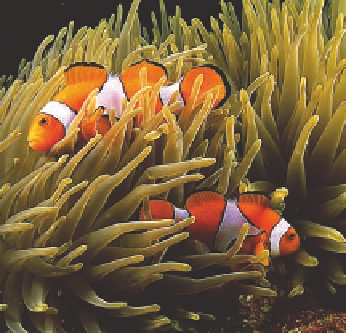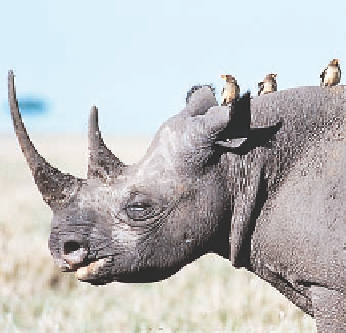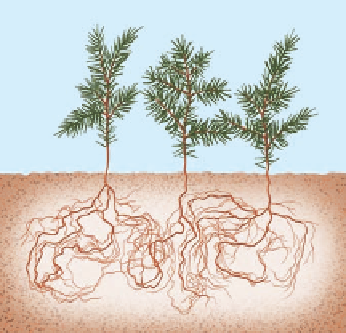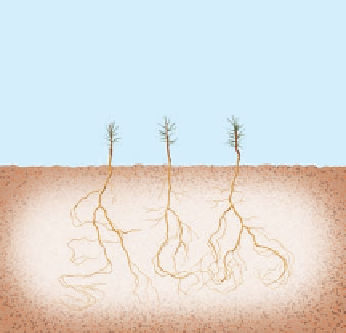Environmental Engineering Reference
In-Depth Information
Parasites: Sponging Off of Others
Although parasites can harm their host organisms,
they may also promote community biodiversity.
Parasitism
occurs when one species (the
parasite
) feed-
son part of another organism (the
host
), usually by liv-
ing on or in the host. Parasitism can be viewed as a spe-
cial form of predation. But unlike a conventional
predator, a parasite usually is much smaller than its
host (prey) and rarely kills its host. Also, most parasites
remain closely associated with, draw nourishment
from, and may gradually weaken their host over time.
Tapeworms, microorganisms that cause disease
(pathogens), and other parasites live
inside
their hosts.
Other parasites attach themselves to the
outside
of their
hosts. Examples include ticks, fleas, mosquitoes, mistle-
toe plants, and sea lampreys that use their sucker-like
mouths to attach themselves to their fish hosts and feed
on their blood. Some parasites move from one host to
another, as fleas and ticks do; others, such as tape-
worms, spend their adult lives with a single host.
From the host's point of view, parasites are harm-
ful. Nevertheless, parasites play important ecological
roles. Collectively, the matrix of parasitic relationships
in a community acts like glue to help hold the species
in a community together. Parasites also promote bio-
diversity by helping keep some species from becoming
so plentiful that they eliminate other species.
Mutualism: Win-Win Relationships
Pollination and fungi that help plant roots take up
nutrients are examples of species interactions that
benefit both species.
In
mutualism,
two species interact in a way that bene-
fits both. Such benefits include having pollen and
seeds dispersed for reproduction, being supplied with
food, or receiving protection. For example, honeybees,
caterpillars and other insects may feed on a male
flower's nectar, picking up pollen in the process, and
then pollinate female flowers when they feed on them.
Figure 6-7 shows three examples of mutualistic re-
lationships that combine
nutrition
and
protection.
One
involves birds that ride on the backs of large animals
like African buffalo, elephants, and rhinoceroses (Fig-
ure 6-7a). The birds remove and eat parasites from the
animal's body and often make noises warning the ani-
mal when predators approach.
A second example involves clownfish species,
which live within sea anemones, whose tentacles sting
and paralyze most fish that
touch them (Figure 6-7b).
The clownfish, which are
not harmed by the tenta-
cles, gain protection from
predators and feed on the
(a)
Oxpeckers and black rhinoceros
(b)
Clownfish and sea anemone
Figure 6-7
Natural capital:
ex-
amples of
mutualism.
(a) Oxpeck-
ers (or tickbirds) feed on parasitic
ticks that infest large, thick-
skinned animals such as the en-
dangered black rhinoceros. (b) A
clownfish gains protection and
food by living among deadly
stinging sea anemones and helps
protect the anemones from some
of their predators. (c) Beneficial
effects of mycorrhizal fungi at-
tached to roots of juniper
seedlings on plant growth com-
pared to (d) growth of such
seedlings in sterilized soil without
mycorrhizal fungi.
(c)
Mycorrhizae fungi on juniper seedlings
in normal soil
(d)
Lack of mycorrhizae fungi on juniper
seedlings in sterilized soil






